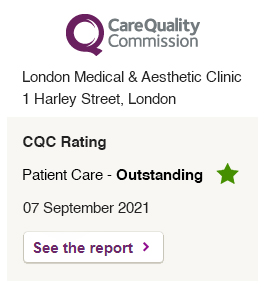Is it the end for Anti-Wrinkle Injections bandwagon among celebrities?
Dr Ayham Al-Ayoubi, a leading surgeon from the London Medical and Aesthetic Clinic on Harley Street, a major reason behind the declining popularity of Anti-Wrinkle Injections is the number of practitioners in Britain who simply don’t administer it correctly.
Whenever she felt low, Carly Rands regularly relied on a secret little pick-me-up to make her feel better.
‘I started on it when I was 34, with my best friend,’ she confesses. ‘Then I had it a couple of times a year and people always commented that I looked really well.’
Carly’s fix was far from being anything illicit. It was Anti-Wrinkle Injections.
Since it first became available for cosmetic use in Britain just over a decade ago, the treatment has been seen as the ultimate quick-fix for wrinkles, with more than a million treatments given here every year.
Along with fillers, which can plump out loose and sagging skin, these injections were collectively billed as the no-knife facelift, the way to turn back the clock without surgery.
For four years, Carly, 38, who lives in Wokingham, Berkshire, was delighted with the results.
She says: ‘I began it when I noticed a few lines I wanted to erase and it worked.
‘Over time, I was persuaded to have a few fillers, too. I wanted it to look natural, but didn’t mind if people noticed because the frozen look was really fashionable.
‘Having had Anti-Wrinkle Injections felt like being part of an exclusive club. But as more and more people started having it done — although nobody said anything negative about it to me — I felt that the cachet had worn off.
‘My friend had a couple of treatments too many and said she felt like she had a permanent headache.’‘Now you see the stars of The Only Way Is Essex with their faces pumped full of it and you think, “I don’t want to look like that”.
I also knew a few people who’d overdone it and started to look weird — stretched and shiny.
Carly, who works for an energy company, had her final treatment at the end of last year. Along with the fillers, her total bill for the session came to an eye-watering £1,200.
For Carly, it was a final wake-up call. ‘If I was going to continue, I would start specially budgeting for it, which seemed slightly ridiculous. I realised I’d had enough.’
And she’s not the only one. After years of Hollywood stars looking so uniformly stretched, puffy and arched of eyebrow that they no longer remotely resemble their former selves, the Anti-Wrinkle Injections backlash is gathering pace.
Women are increasingly rejecting Anti-Wrinkle Injections and turning instead to anti-ageing treatments that deliver a more natural result.
A survey in July by The Cosmetic Surgery Guide found that three out of four women in Britain who have tried Anti-Wrinkle Injections would welcome a non-invasive alternative to injections.
Even Hollywood stars are going off it — Gwyneth Paltrow recently said it made her look ‘crazy’, adding: ‘I looked like Joan Rivers (the famously cosmetically adjusted American comedian).’

Anti-Wrinkle Injections:
Dr Ayham Al-Ayoubi, a leading surgeon who owns the London Medical and Aesthetic Clinic on Harley Street, a major reason behind the declining popularity of Anti-Wrinkle Injections is the number of practitioners in Britain who simply don’t administer it correctly.
‘If used to soften lines on the forehead, Anti-Wrinkle Injections can give very good results. But the problems come when it’s injected into the lower part of the face.
‘This is what gives a frozen appearance, which I call “celebrity face”. While it might be wrinkle-free, it’s also expression-free.
‘The correct technique is very delicate. Practitioners must know exactly where to inject it and precisely how much to use, to keep the natural look of the face.’
Anti-Wrinkle Injections has been so successful because it is so simple. When it is injected, it blocks the signals from the nerve to the muscle. The muscle is paralysed and the skin doesn’t move, resulting in fewer or shallower wrinkles.
A paper published in the Journal Of The European Academy of Dermatology in 2008 showed that when you remove the wrinkles from an image, a person is perceived as ten years younger than they really are, but when you remove the wrinkles and even out the pigmentation, the person is perceived as almost 16 years younger.But the beauty industry is realising that it isn’t necessarily wrinkles that make us look older.
And so, a new generation of treatments is springing up to fulfil the demand for more natural-looking ways to slow down the ageing process.
Dr Ayham Al-Ayoubi believes women want treatments that help them achieve a fresh, radiant version of themselves rather than the frozen look associated with Anti-Wrinkle Injections.
In place of needles, there are lasers, peels and radio-frequency energy treatments, all of which work by stimulating the production of collagen and elastin, the proteins that make skin firm, plump and youthful, in turn rejuvenating the complexion.
These new non-invasive procedures are often cheaper than Anti-Wrinkle Injections and can take years off a face without leaving it immobile.
After Carly ditched her Anti-Wrinkle Injections regime, she began to look for something more natural.
‘I’d see celebrities looking great, yet who still had everything moving, and I wanted to know how to get that look.’ she says.
Carly discovered a treatment called Venus Freeze, which has been used by celebrities including Yasmin Le Bon. It combines pulse magnetic fields and radio frequency to raise the temperature of the skin and stimulate it to repair itself.
Carly has had the treatment twice so far.
‘I’ve found it a much nicer, more relaxing experience than Anti-Wrinkle Injections,’ she says.
‘It just feels like a facial rather than something medical. There are no needles, nothing’s injected. They hold a probe to your face and you can feel the pulses, but there’s no pain.
‘They combine it with a peel and a facial massage, so it feels like being pampered. The best part is that you can see results straight away — my skin looked instantly plumper and more youthful.
‘It costs around £100 a time and my plan is to have a treatment every couple of months, so it’s much cheaper than my Anti-Wrinkle Injections and fillers, which I’d started doing a couple of times a year at around £1,200 a go.’
Lorraine Fleming, 44, from Erskine in Renfrewshire, is another woman who has rejected Anti-Wrinkle Injections. A regular user for seven years, she’d relied on the injections to make her look fresher and less tired.
As her 40s progressed, Anti-Wrinkle Injections gave her the confidence that the wrinkles would be kept at bay.
Then came the tipping point. Two years ago, she arrived home after yet another Anti-Wrinkle Injections session, and instantly know that something felt and looked completely different. The doctor had injected far too much into her skin, with terrible results.
‘I felt as though I had a metal plate under the skin of my forehead,’ says Lorraine, who is separated and has two daughters.
‘I had no movement in my face whatsoever. It was so leaden that it was pushing my eyebrows down, making my eyes look half-closed, and my forehead was very shiny.
‘I never wanted to look “done”, just fresh, but this looked very obvious and felt awful. I knew it was time to stop the Anti-Wrinkle Injections.’
For 16 years, she’d suffered from a form of leukaemia called thrombocythemia, which cannot be cured, but is controlled with a type of long-term chemotherapy. But Lorraine had deeper worries.
‘I’d always had misgivings about injecting a toxin into my body, but when my last treatment left my face looking so unnatural, it really brought home to me that I was pumping myself full of unnecessary chemicals,’ she says.
And so she began looking into healthier, more ‘natural’ treatments. After consultations at the Brow Studio in Glasgow, she began to try Image Skincare facial peels.
‘They feel so much gentler than Anti-Wrinkle Injections. They contain glycolic acid, an acid derived from sugar cane, to remove the dull top layer of skin and stimulate collagen production.
‘It reveals new skin underneath, which is brighter and plumper. These peels have evened out my skin tone and made it much more radiant than Anti-Wrinkle Injections ever did.’
Dr Ayham Al-Ayoubi, consumers are increasingly looking for solutions like this, which don’t involve introducing a known poison to your body.
‘In the last year or so, I’ve seen a 20 or 30 per cent increase in the number of women asking for non-artificial treatments and products,’ he says.
‘People have started to have serious concerns about Anti-Wrinkle Injections and the results it gives, and they want to improve their skin in a more natural way.’
While Anti-Wrinkle Injections does have a good safety record, many women are understandably spooked by the fact it is a toxin. And this isn’t helped by unscrupulous practitioners who give the drug a bad name.
‘Some doctors in Britain use unauthorised products from China and other foreign countries, meaning they can’t be sure of the quality or concentration of the product they’re injecting,’ says Dr Ayoubi.
For other devotees, the drug loses its potency when used over a long period of time.
Amanda Lewis, a 48-year-old nurse from Lymm in Cheshire, had Anti-Wrinkle Injections for ten years, starting when she was 35.
At first, she was delighted with the results, but after her last couple of treatments, noticed it wasn’t softening her lines as it had previously.
‘When I first had Anti-Wrinkle Injections to treat the frown lines I’d noticed around my eyes, I was adamant I didn’t want to look dramatically different — I just wanted to look as good as I could as I got older,’ says Amanda.
‘It didn’t make a radical difference; I just looked a bit fresher, which was great. People have often told me I look young for my age, and I loved getting compliments. Anti-Wrinkle Injections gave me a bit of extra confidence.
‘I didn’t have it regularly at first, but as time went on I began having it two or three times a year at a cost of around £350 a time.
‘After a while, it stopped working. My lines were still visible after my last treatments, which was disappointing. The doctor told me some people can become resistant to Anti-Wrinkle Injections and that it had happened to me.’
Dr Ayham Al-Ayoubi says this is a common result of doctors over-using Anti-Wrinkle Injections on a patient.
‘The results should last up to six months the first time, then between six and nine months the second,’ he says.
‘Then, after a couple of years, the results should last for at least 12 months.
‘People who have it two or three times a year are having far too much. This can cause muscle atrophy — a condition that causes the muscle to shrink because it isn’t active — and Anti-Wrinkle Injections no longer works as a result.’
Instead, Amanda now uses a laser treatment called Harmony Clear Lift, which encourages skin to regenerate collagen at a deep level without damaging the skin’s surface.
‘It takes half an hour and there’s no pain, unlike Anti-Wrinkle Injections, which stings,’ says Amanda, who is treated at the Courthouse Clinic in Wilmslow, Cheshire.
‘I wear goggles while the doctor shoots little pulses into each area of my face. There’s no redness afterwards, and I started to see results after my second session.
‘In total, I’ve had four treatments two weeks apart and I’ll probably have maintenance treatments every year.
‘It costs a similar amount to Anti-Wrinkle Injections, but I’m happier with the results. My skin looks firmer, smoother and tighter, but I can still move it, whereas with Anti-Wrinkle Injections I couldn’t frown.
‘With Anti-Wrinkle Injections, I was always aware a foreign substance was being injected into my face, whereas Clear Lift works by stimulating my own collagen.
‘As women get older, we just want to look like the best possible version of ourselves — not somebody else entirely.’
With more and more women echoing Amanda’s views, a needle-free future may not be far off.
To view all posts by Dr Ayham Al-Ayoubi, click here





